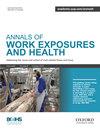190 酶的安全管理:为清洁专业人员及其员工提供风险管理指导
IF 1.8
4区 医学
Q3 PUBLIC, ENVIRONMENTAL & OCCUPATIONAL HEALTH
引用次数: 0
摘要
专业清洁产品被广泛应用于各种场合,从医院、办公室、酒店、餐馆、护理院和公共交通等私人和公共设施的清洁,到工作场所和食品、饮料、药品等工业生产过程的清洁。多年来,酶一直被安全地用作洗衣粉等消费产品的功能成分,并广泛用于制造、医疗保健和服务行业的织物和衣物批量洗涤的专业产品中。酵素还被用于小众专业产品,如清洁内窥镜的溶液,以及专门的下水道和表面清洁剂。酵素具有很好的安全性,但与许多其他蛋白质一样,酵素可作为呼吸道致敏物质,因此可能导致过敏症状,如鼻炎。为了更好地解决中小型企业的安全使用问题,AISE(国际肥皂、洗涤剂和保养产品协会)、ACI(美国清洁协会)、HCPA(家用和商用产品协会)和酶供应商联合制定了专业清洁剂风险评估和风险交流指南。参加本次讨论的人员将了解风险、风险管理措施以及与专业产品用户的雇主和使用含酶专业产品的员工讨论的关键风险交流主题。本文章由计算机程序翻译,如有差异,请以英文原文为准。
190 Safety stewardship of enzymes: reaching cleaning professionals with risk management guidance for professionals and their employees
Professional cleaning products are used in a wide variety of situations, from cleaning of private and public facilities such as hospitals, offices, hotels, restaurants, care homes and public transport, to cleaning of workplaces and industrial process involved in the manufacturing of foods, beverages, pharmaceuticals, and others. For many years enzymes have been used safely as a functional ingredient in consumer products such as laundry detergents and are widely in professional products for bulk laundering of fabrics and clothing from the manufacturing, healthcare and service industries. Enzymes have also been used in niche professional products such as solutions for cleaning endoscopes, and specialized drain and surface cleaners. Enzymes have a very good safety profile but, as with many other proteins, they can act as respiratory sensitizers and so may lead to allergy symptoms, such as rhinitis. In order to better address safe use across small and medium enterprises the AISE (International Association for Soaps, Detergents and Maintenance Products), the ACI (American Cleaning Institute), the HCPA (Household and Commercial Products) and enzyme suppliers joined forces to create guidance for risk assessment and risk communication for professional cleaners. Attendees at this discussion will develop an understanding of the risk, risk management measures, and critical risk communication topics to be discussed with employers of professional products users and employees working with enzyme containing professional products themselves.
求助全文
通过发布文献求助,成功后即可免费获取论文全文。
去求助
来源期刊

Annals Of Work Exposures and Health
Medicine-Public Health, Environmental and Occupational Health
CiteScore
4.60
自引率
19.20%
发文量
79
期刊介绍:
About the Journal
Annals of Work Exposures and Health is dedicated to presenting advances in exposure science supporting the recognition, quantification, and control of exposures at work, and epidemiological studies on their effects on human health and well-being. A key question we apply to submission is, "Is this paper going to help readers better understand, quantify, and control conditions at work that adversely or positively affect health and well-being?"
We are interested in high quality scientific research addressing:
the quantification of work exposures, including chemical, biological, physical, biomechanical, and psychosocial, and the elements of work organization giving rise to such exposures;
the relationship between these exposures and the acute and chronic health consequences for those exposed and their families and communities;
populations at special risk of work-related exposures including women, under-represented minorities, immigrants, and other vulnerable groups such as temporary, contingent and informal sector workers;
the effectiveness of interventions addressing exposure and risk including production technologies, work process engineering, and personal protective systems;
policies and management approaches to reduce risk and improve health and well-being among workers, their families or communities;
methodologies and mechanisms that underlie the quantification and/or control of exposure and risk.
There is heavy pressure on space in the journal, and the above interests mean that we do not usually publish papers that simply report local conditions without generalizable results. We are also unlikely to publish reports on human health and well-being without information on the work exposure characteristics giving rise to the effects. We particularly welcome contributions from scientists based in, or addressing conditions in, developing economies that fall within the above scope.
 求助内容:
求助内容: 应助结果提醒方式:
应助结果提醒方式:


